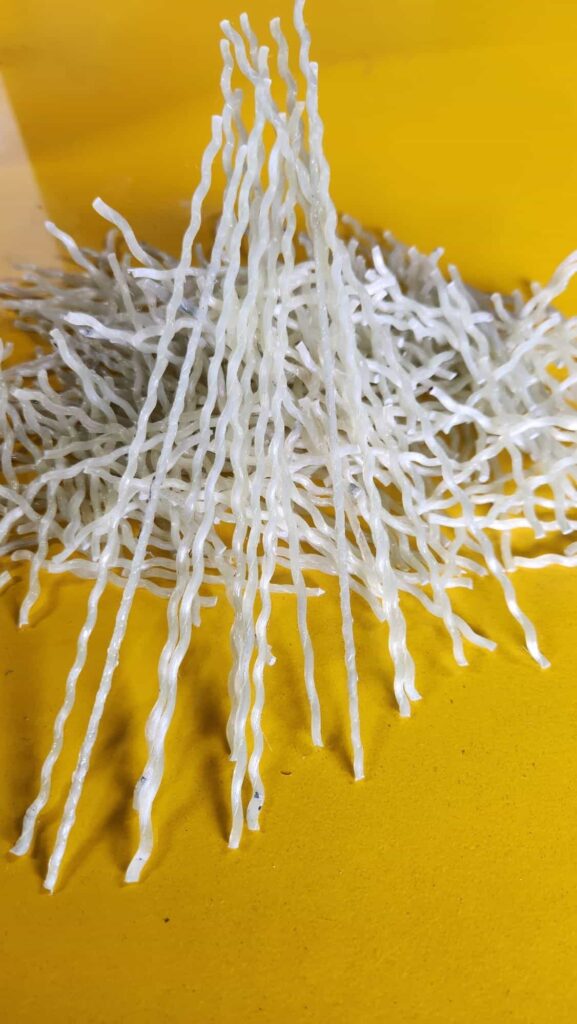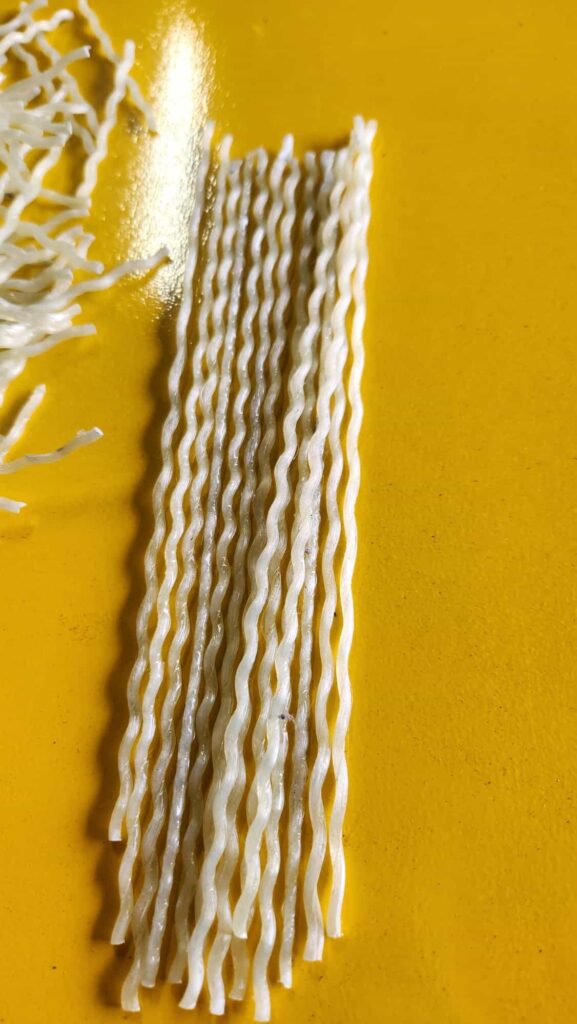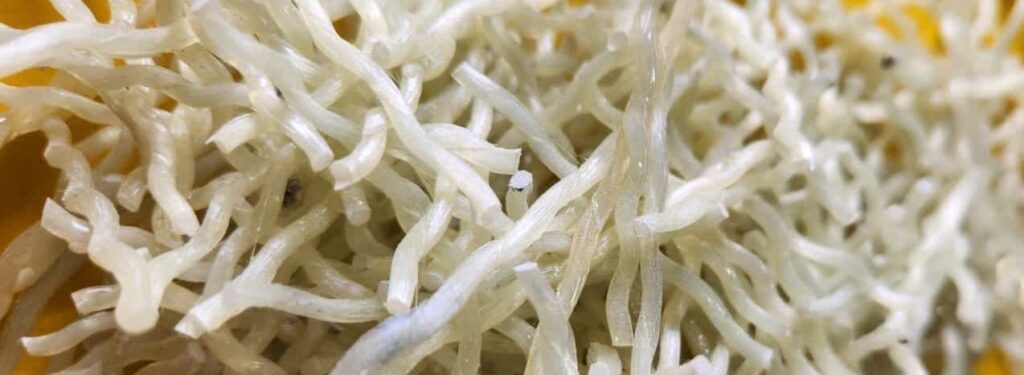يتطلب قطاع البناء مواد تلبي معايير الأداء المتزايدة باستمرار. ولطالما كانت ألياف الفولاذ الخيار الأمثل لتسليح الخرسانة، إلا أن المواد المركبة المبتكرة، مثل ألياف GFRP (البوليمر المقوى بألياف الزجاج)، تقدم أداءً متفوقًا بكثير. في هذه المقالة، سنناقش مزايا ألياف GFRP مقارنةً بألياف الفولاذ التقليدية، ونقدم أحدث المعدات التي طورتها شركة Composite-Tech لإنتاج ألياف GFRP.
النقاط الرئيسية
- ألياف GFRP هي مادة مركبة مصنوعة من ألياف زجاجية مدمجة في راتنجات البوليمر.
- استخدام ألياف GFRP في تسليح الخرسانة يفتح إمكانيات جديدة لتحسين جودة ومتانة مشاريع البناء.
- مزايا ألياف GFRP على الفولاذ: قوة أعلى، ومقاومة للتآكل، ووزن أخف، وعمر خدمة أطول.
- تقدم شركة Composite-Tech خدمات متقدمة معدات مصممة لإنتاج ألياف GFRP عالية الجودة.
- توفر شركة Composite-Tech خدمة دورة كاملة للمعدات، بما في ذلك التثبيت والمعايرة وتدريب الموظفين والصيانة الدورية.
ما هي ألياف GFRP؟
ألياف GFRP مادة مركبة مصنوعة من ألياف زجاجية مدمجة في راتنجات بوليمرية. تُخلط هذه الألياف بالخرسانة لتعزيز قوتها ومقاومتها للتشقق ومتانتها. يكتسب استخدام ألياف البلاستيك المقوى بألياف الزجاج (GFRP) في البناء شعبية متزايدة بفضل خصائصها الميكانيكية الاستثنائية وأدائها طويل الأمد مقارنةً بالمواد التقليدية كالفولاذ.
مزايا ألياف GFRP مقارنة بألياف الفولاذ
- قوة شد أعلى
تتميز ألياف GFRP بقوة شد تتراوح بين 1000 و1600 ميجا باسكال، أي أكثر من ضعف قوة شد ألياف الفولاذ التقليدية، التي تتراوح بين 400 و600 ميجا باسكال. هذا يجعل الألياف المركبة أكثر فعالية بكثير في تسليح الخرسانة، خاصةً في التطبيقات عالية الإجهاد التي تنطوي على أحمال شديدة. - مقاومة التآكل
ألياف الفولاذ شديدة التأثر بالتآكل، خاصةً في البيئات الرطبة أو الكيميائية، مما يؤثر سلبًا على عمرها الافتراضي ومتانتها. في المقابل، تتميز ألياف البلاستيك المقوى بألياف الزجاج (GFRP) بمقاومة كاملة للتآكل، مما يجعلها مثالية للبيئات البحرية والصناعية والكيميائية حيث يتدهور الفولاذ بمرور الوقت. - خفيف الوزن وسهل التعامل
ألياف GFRP أخف وزنًا من الفولاذ بأربع إلى خمس مرات، مع خصائص أداء مماثلة. هذا يُخفِّض الوزن الإجمالي للهياكل الخرسانية، ويُبسِّط النقل والتركيب. كما يُقلِّل استخدام الألياف المُركَّبة تكاليف اللوجستيات والعمالة بشكل كبير. - المقاومة الكيميائية
تتميز ألياف البلاستيك المقوى بألياف الزجاج (GFRP) بمقاومتها للأحماض والقلويات والأملاح، مما يضمن ثباتها في البيئات الكيميائية العدوانية. أما ألياف الفولاذ، فهي عرضة للتأثيرات الكيميائية، مما يُقصّر من عمر الهياكل الخرسانية المسلحة. - عمر أطول للهياكل
بفضل متانتها الفائقة، تُطيل ألياف GFRP عمر الهياكل الخرسانية المسلحة بمقدار مرتين إلى ثلاث مرات مقارنةً بألياف الفولاذ. وهذا يجعلها خيارًا اقتصاديًا فعالًا للمشاريع طويلة الأمد، مثل الجسور والأنفاق والبنى التحتية الضخمة. - الخمول الكهرومغناطيسي
ألياف GFRP غير موصلة للكهرباء، مما يجعلها مثالية للاستخدام في البيئات الحساسة للمجالات الكهرومغناطيسية، مثل محطات الطاقة، وأنظمة مترو الأنفاق، والبنية التحتية للاتصالات. بخلاف الألياف الفولاذية التي قد تسبب تداخلاً كهرومغناطيسياً، لا تُشكل الألياف المركبة أي خطر على المعدات الحساسة.
مقارنة بين ألياف البلاستيك المقوى بألياف الفولاذ (GFRP) وألياف الفولاذ (Fleet Fibers): جدول المقارنة
| المعلمة | ألياف GFRP | ألياف الفولاذ |
| قوة الشد (ميجا باسكال) | 1000–1600 | 400–600 |
| مقاومة التآكل | ممتلىء | قليل |
| وزن | خفيف الوزن (أخف وزنًا بمقدار 4 إلى 5 مرات) | ثقيل |
| المقاومة الكيميائية | عالي | قليل |
| الموصلية الكهربائية | غير موصل | موصل |
| طول العمر الهيكلي | أعلى بمقدار 2-3 مرات | يتم تقليله في البيئات المسببة للتآكل |
| تكاليف الصيانة | أقل (لا حاجة للاستبدال المتكرر) | أعلى (بسبب التآكل) |
معدات تصنيع ألياف GFRP
من الجوانب الأساسية لإنتاج ألياف GFRP التكنولوجيا التي تضمن الدقة والاتساق أثناء الإنتاج. تقدم Composite-Tech معدات متطورة مصممة لإنتاج ألياف GFRP عالية الجودة، وتتميز بالمزايا التالية:
- كفاءة إنتاج عالية
تم تصميم معداتنا لضمان إنتاج عالي السرعة مع الحد الأدنى من النفايات، مما يسمح بزيادة القدرة الإنتاجية وخفض التكاليف. - الأتمتة لتحقيق أقصى قدر من الدقة
عملية الإنتاج بأكملها مؤتمتة بالكامل، مما يقلل من الأخطاء البشرية ويضمن جودة المنتج. يمكن للمشغلين مراقبة الإنتاج والتحكم فيه من خلال أنظمة متكاملة، مما يُبسط تشغيل المعدات. - كفاءة الطاقة
صُممت معدات Composite-Tech لتلبية معايير كفاءة الطاقة الحديثة، مما يُسهم في تقليل استهلاك الطاقة الإجمالي أثناء إنتاج الألياف. وهذا أمرٌ بالغ الأهمية ليس فقط لخفض تكاليف التشغيل، بل أيضاً للحد من الأثر البيئي. - التنوع
تستطيع آلاتنا إنتاج ليس فقط ألياف GFRP القياسية للخرسانة ولكن أيضًا ألياف بأحجام وخصائص مختلفة، مما يجعلها قابلة للتكيف مع متطلبات البناء المتنوعة. - الخدمة والدعم الشامل
تقدم Composite-Tech خدمة متكاملة لمعداتنا، تشمل التركيب والمعايرة وتدريب الموظفين والصيانة الدورية. هذا يضمن تشغيلًا سلسًا وعمرًا افتراضيًا أطول.
خاتمة
يتيح استخدام ألياف GFRP في تسليح الخرسانة إمكانيات جديدة لتحسين جودة ومتانة مشاريع البناء. وتتجلى مزايا ألياف GFRP مقارنةً بالفولاذ بوضوح: قوة أعلى، ومقاومة للتآكل، ووزن أخف، وعمر خدمة أطول. وبدمج ألياف GFRP في مشاريع البناء، فإنك لا تُحسّن فقط الخواص الميكانيكية للخرسانة، بل تُقلل أيضًا بشكل كبير من تكاليف الصيانة والاستبدال، مما يجعلها الخيار الأمثل للمشاريع قصيرة وطويلة الأجل.
معدات Composite-Tech المتطورة نضمن إنتاجًا عالي الجودة لألياف GFRP، لتلبية احتياجات البناء الحديث. نفخر بتقديم حلول مبتكرة للسوق تُسهم في بناء هياكل أكثر أمانًا وعمرًا أطول وصديقة للبيئة.
الفوائد الرئيسية لألياف GFRP لتحسين محركات البحث:
- قوة الشد العالية:أكثر من 1600 ميجا باسكال، مما يوفر تعزيزًا لا مثيل له للهياكل الخرسانية.
- مقاومة التآكل:توفر ألياف GFRP حماية كاملة ضد التآكل، مما يضمن متانة طويلة الأمد في البيئات العدوانية.
- خفيف الوزن ومتعدد الاستخدامات:ألياف GFRP الخاصة بنا أخف من الفولاذ بـ 4-5 مرات، مما يجعلها سهلة النقل والتركيب في الموقع.
- الإنتاج الصديق للبيئة:تعمل معدات Composite-Tech بكفاءة عالية في استخدام الطاقة مع الحد الأدنى من النفايات، مما يعزز ممارسات البناء المستدامة.
عن طريق اختيار ألياف GFRP من Composite-Tech، فأنت تستثمر في مستقبل البناء - حلول أقوى وأخف وزناً وأكثر متانة لتقوية الخرسانة.




